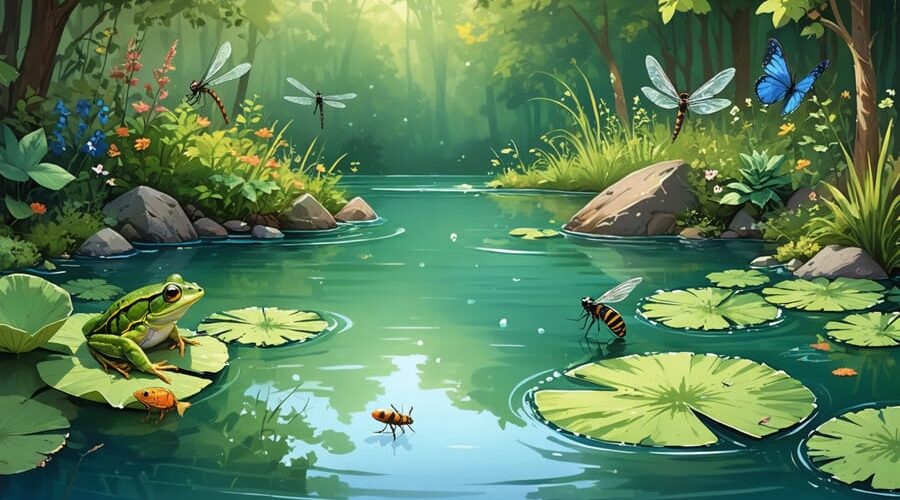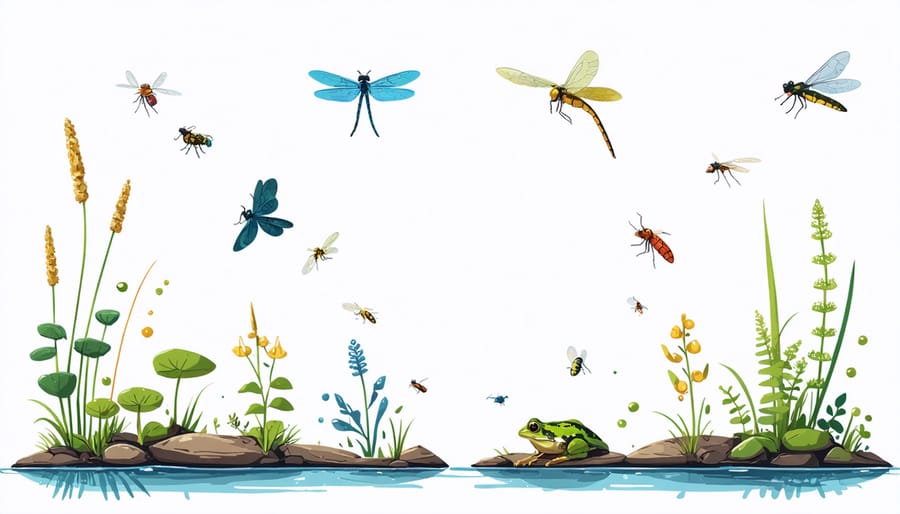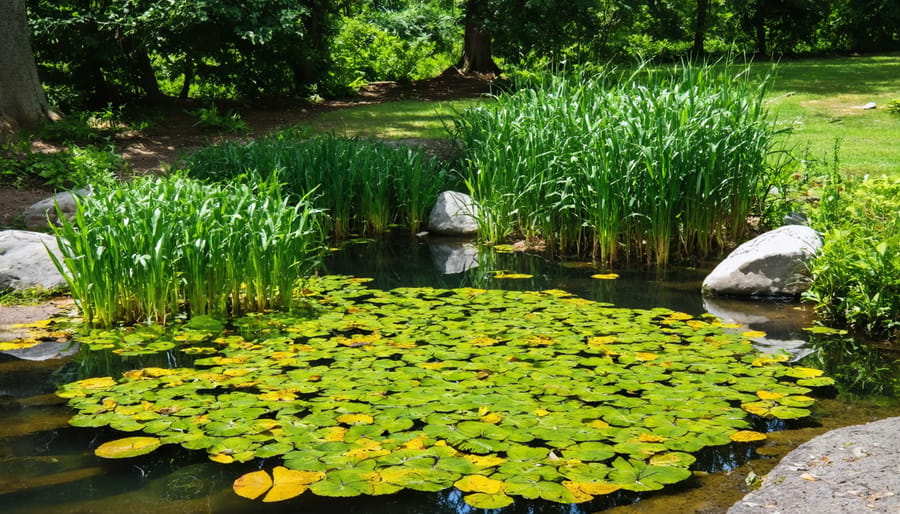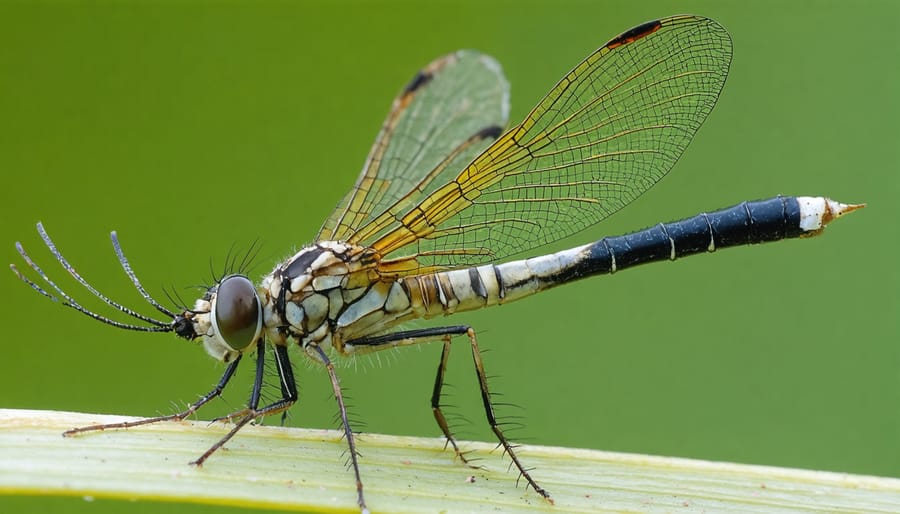
Natural Pond Pest Control That Actually Works (Without Harsh Chemicals)
Transform your pond’s pest management by embracing nature’s own defense mechanisms. Sustainable pest control starts with creating a balanced ecosystem where beneficial insects, fish, and plants work together to keep harmful pests in check. Traditional chemical pesticides often disrupt this delicate balance, leading to recurring problems and potential harm to desirable pond inhabitants.
Smart pond design incorporates natural pest deterrents like floating plants that shade the water, reducing algae growth while providing shelter for pest-eating insects. Strategic placement of native species creates a self-regulating environment where predator-prey relationships naturally control pest populations. These biological controls prove more effective and longer-lasting than quick-fix chemical solutions.
Implementing sustainable pest management doesn’t mean sacrificing effectiveness. By combining preventive measures like proper filtration, regular maintenance, and careful plant selection with natural control methods, pond owners achieve superior results without environmental compromise. This approach not only resolves immediate pest issues but builds a resilient ecosystem that becomes increasingly self-maintaining over time.
The key lies in viewing pests not as enemies to eliminate, but as indicators of ecosystem imbalance to address through holistic, sustainable solutions that enhance your pond’s overall health and beauty.
Understanding Your Pond’s Ecosystem

Identifying Common Pond Pests
Understanding common pond pests is the first step in maintaining a healthy water garden. Algae blooms are perhaps the most frequent challenge, turning crystal-clear water into a murky green soup and potentially harming fish populations. Mosquito larvae can quickly transform your peaceful pond into a breeding ground for these pesky insects, while pond snails might overtake your water plants if left unchecked.
Water-dwelling insects like diving beetles and water boatmen can damage young fish and destroy floating plants. String algae, also known as blanket weed, can wrap around pump systems and create unsightly masses on the water’s surface. Some pond owners also struggle with duckweed, a tiny floating plant that can double in quantity every few days, eventually covering the entire water surface.
These unwanted visitors not only affect your pond’s appearance but can also impact the overall ecosystem balance, potentially harming beneficial organisms and reducing oxygen levels. Being able to identify these issues early helps you take prompt, appropriate action while maintaining your pond’s natural harmony.
The Role of Beneficial Organisms
Nature’s own pest control squad plays a vital role in maintaining a healthy pond ecosystem. Beneficial organisms like ladybugs, praying mantises, and parasitic wasps act as natural predators, keeping problematic pest populations in check without the need for harsh chemicals.
Dragonflies and damselflies are particularly helpful in controlling mosquitoes and other flying insects, while ground beetles feast on slugs and snails that might damage your pond plants. Frogs and toads are excellent allies too, consuming various insects and their larvae.
In your pond, beneficial bacteria help break down organic matter and maintain water quality, while certain aquatic insects like water striders and backswimmers feed on mosquito larvae. Even tiny organisms like rotifers and water fleas play their part by consuming algae and other microscopic pests.
To encourage these helpful creatures, create diverse habitats around your pond with native plants, rock piles, and shallow areas. Avoid using pesticides that might harm these natural pest controllers, and you’ll soon have a thriving, self-regulating ecosystem in your garden.
Preventive Measures That Work
Water Quality Management
Proper water quality management is your first line of defense against unwanted pests in your pond ecosystem. To maintain optimal water conditions, regular testing and monitoring of key parameters is essential. Start by checking pH levels weekly, aiming for a range between 6.8 and 7.8, which naturally discourages many common pests.
Ensure your pond has adequate filtration and aeration systems running 24/7. Good water circulation prevents stagnant areas where mosquitoes and other nuisance insects love to breed. Adding a fountain or waterfall not only creates beautiful movement but also increases oxygen levels, making the environment less hospitable for problematic organisms.
Regular cleaning is crucial – remove fallen leaves and debris before they can decompose and affect water quality. Consider installing a bottom drain or using a pond vacuum to keep the substrate clean. This reduces nutrients that harmful algae and parasites need to thrive.
Balance your pond’s ecosystem by incorporating plenty of beneficial plants. Water lilies and floating plants provide shade and compete with algae for nutrients, while submerged plants release oxygen and filter the water naturally. A well-planted pond is more resistant to pest invasions and requires less intervention to stay healthy.
Remember to avoid overfeeding fish, as excess food breaks down and degrades water quality. A simple rule of thumb: only feed what your fish can consume within five minutes.
Plant Selection and Maintenance
Selecting the right plants for your pond ecosystem is one of the most effective ways to naturally deter pests. Start by choosing native aquatic plants that are already adapted to your local climate and naturally resistant to common pests. Consider incorporating floating plants like water lilies and lotus, which help shade the water and reduce algae growth while providing shelter for beneficial insects.
Create diverse plant zones in and around your pond using a combination of submerged, floating, and marginal plants. Aromatic plants like lavender, mint, and lemon balm around the pond’s edge naturally repel many unwanted insects while attracting beneficial pollinators. Water iris and rushes not only look beautiful but also help filter the water and provide hiding spots for natural pest predators like dragonflies.
Maintain your plants by regularly removing dead or decaying material, which can attract pests and affect water quality. Trim back excessive growth to maintain proper water flow and prevent overcrowding. When adding new plants, quarantine them for a week to ensure they’re pest-free before introducing them to your pond.
For optimal pest resistance, ensure your plants receive proper nutrition without over-fertilizing, which can lead to algae problems. Healthy plants naturally ward off pests and disease, creating a balanced ecosystem that largely manages itself.

Natural Control Methods
Biological Controls
Nature provides some of the most effective solutions for pest control in ponds through biological control methods that work harmoniously with your ecosystem. By introducing beneficial organisms, you can create a natural balance that keeps pest populations in check without harmful chemicals.
One of the most popular approaches is adding predatory fish like mosquito fish (Gambusia) to control mosquito larvae. These tiny warriors can consume hundreds of larvae daily while adding life to your pond. Similarly, dragonfly nymphs are excellent natural predators that feast on various aquatic pests and mosquito larvae.
Beneficial bacteria play a crucial role too. These microscopic helpers break down organic matter and compete with harmful bacteria for nutrients, naturally maintaining water quality. For algae control, consider introducing daphnia (water fleas) and rotifers, which feed on single-celled algae and help keep the water clear.
Don’t forget about plants! Water lilies and floating plants provide shade that discourages algae growth while offering shelter for beneficial insects. Adding barley straw or barley extract can also inhibit algae growth naturally.
Remember to introduce these beneficial organisms gradually and monitor their impact. It’s about creating a balanced ecosystem where natural predators and beneficial organisms work together to keep your pond healthy and pest-free.

Physical Controls
Physical pest control methods offer a hands-on, chemical-free approach to managing unwanted visitors in your garden and around your home. One of the most straightforward techniques is manual removal, where you can physically pick off pests or use tools like pruners to remove affected plant parts. For larger pests, consider setting up humane traps that allow for catch-and-release away from your property.
Installing physical barriers is another effective strategy. Fine mesh netting can protect vulnerable plants from birds and insects, while copper tape around plant containers deters slugs and snails. Floating row covers work wonders for vegetable gardens, creating a protective shield while still allowing sunlight and water to reach your plants.
For structural pest control, seal entry points around your home’s foundation, windows, and doors with appropriate materials like caulk or weatherstripping. Install screens on windows and doors to keep flying insects out while maintaining ventilation. In garden areas, consider raising your beds with hardware cloth bottoms to prevent burrowing pests from accessing your plants from below.
Remember to regularly inspect and maintain these physical controls. Clean and repair barriers as needed, and adjust them seasonally to ensure they remain effective. While these methods require more hands-on effort than chemical alternatives, they provide long-lasting protection without introducing harmful substances into your environment.
Safe Natural Treatments
When it comes to treating pond pests naturally, there are several effective options that won’t harm your ecosystem. One of the most popular methods is introducing beneficial bacteria, which help maintain water quality and reduce algae growth. These microscopic helpers break down organic matter and compete with harmful organisms for nutrients.
Barley straw is another time-tested solution that naturally inhibits algae growth when placed in mesh bags around your pond. As it decomposes, it releases compounds that discourage algae without affecting other plants or wildlife. Similarly, adding aquatic plants like water lilies and hornwort helps shade the water and reduce nutrients available to unwanted organisms.
For insect control, consider adding mosquito-eating fish like gambusia or installing bird-friendly features to attract natural predators. Nematodes, microscopic worms that target specific pests, can be introduced to control problematic larvae in and around your pond.
Essential oils like neem and citronella can be used sparingly around the pond’s edges to deter certain insects, while food-grade diatomaceous earth can help manage crawling pests on nearby plants and surfaces. Remember to use these treatments moderately and observe their effects on your pond’s ecosystem.
For larger pests like herons, physical deterrents such as decoy predators or motion-activated sprinklers offer humane solutions without causing harm. Regular monitoring and maintaining proper water quality are key to preventing pest problems before they start.
Monitoring and Maintenance
Early Warning Signs
Catching pest problems early can save you time, money, and frustration in the long run. Keep an eye out for sudden changes in water clarity or unusual odors, which often signal the beginning of an algae bloom. Watch your fish’s behavior – if they’re rubbing against surfaces or gasping at the surface, this could indicate parasites or poor water quality.
Regular water testing is your best friend. Test for ammonia, nitrites, and pH levels at least weekly, and make note of any significant changes. Unexplained plant damage, particularly holes in leaves or dying patches, might suggest the presence of harmful insects or snails.
Look for signs of overfeeding, like excess food floating on the surface or accumulating on the bottom. This can lead to water quality issues and attract unwanted pests. Check your pond edges for signs of burrowing animals or damage to the liner.
Morning inspections are particularly revealing – many issues are most visible at dawn when the pond is calm. By staying vigilant and addressing these warning signs promptly, you can prevent minor issues from becoming major headaches.
Seasonal Management Tips
Effective pest management requires adapting your strategies as seasons change. In spring, focus on prevention by removing dead plant material and checking water quality as temperatures rise. This is also the perfect time to introduce beneficial bacteria and establish natural predator populations like dragonfly nymphs.
Summer calls for vigilant monitoring of algae growth and mosquito populations. Keep water moving with fountains or waterfalls, and trim back excess plant growth that might harbor unwanted pests. Consider adding floating plants to provide shade and reduce algae proliferation.
Fall is crucial for preparation – remove falling leaves promptly and gradually reduce feeding as temperatures drop. This helps prevent excess nutrients that could lead to spring pest problems. Install protective netting to catch falling leaves before they enter the water.
Winter maintenance is minimal, but maintaining a small hole in ice coverage is essential for gas exchange. Use this quieter season to plan next year’s pest management strategy and research new sustainable control methods. Remember that consistent, season-appropriate care is key to preventing major pest issues throughout the year.
Sustainable pest management in your pond is more than just a trendy approach – it’s a responsible way to maintain a thriving aquatic ecosystem while protecting the environment. By implementing the natural control methods we’ve discussed, you can effectively manage pest problems without resorting to harmful chemicals or quick fixes that might damage your pond’s delicate balance.
Remember that prevention is always better than cure. Regular maintenance, proper plant management, and maintaining healthy water quality form the foundation of pest-free pond keeping. Working with nature rather than against it not only helps control unwanted pests but also promotes biodiversity and creates a more resilient ecosystem.
The key to success lies in patience and consistency. Natural solutions may take longer to show results compared to chemical treatments, but their long-term benefits far outweigh any temporary convenience. By encouraging beneficial insects, introducing natural predators, and maintaining proper water circulation, you’re creating a self-regulating system that can handle most pest issues on its own.
Start small and gradually incorporate these sustainable practices into your pond maintenance routine. Monitor the results, adjust as needed, and share your experiences with fellow pond enthusiasts. Together, we can create beautiful, healthy water gardens that benefit not just our immediate environment but contribute to broader ecological sustainability.
